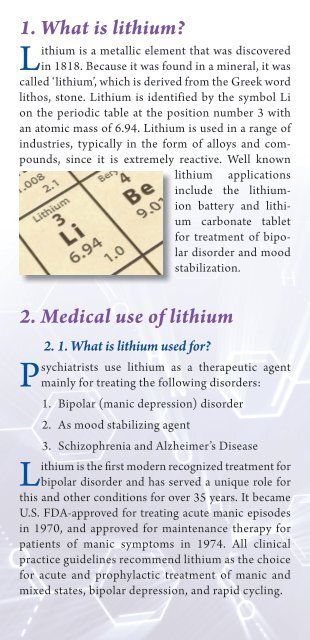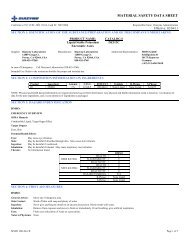Lithium test - Diazyme Laboratories
Lithium test - Diazyme Laboratories
Lithium test - Diazyme Laboratories
You also want an ePaper? Increase the reach of your titles
YUMPU automatically turns print PDFs into web optimized ePapers that Google loves.
1. What is lithium?<br />
<strong>Lithium</strong> is a metallic element that was discovered<br />
in 1818. Because it was found in a mineral, it was<br />
called ‘lithium’, which is derived from the Greek word<br />
lithos, stone. <strong>Lithium</strong> is identified by the symbol Li<br />
on the periodic table at the position number 3 with<br />
an atomic mass of 6.94. <strong>Lithium</strong> is used in a range of<br />
industries, typically in the form of alloys and compounds,<br />
since it is extremely reactive. Well known<br />
lithium applications<br />
include the lithiumion<br />
battery and lithium<br />
carbonate tablet<br />
for treatment of bipolar<br />
disorder and mood<br />
stabilization.<br />
2. Medical use of lithium<br />
2. 1. What is lithium used for?<br />
Psychiatrists use lithium as a therapeutic agent<br />
mainly for treating the following disorders:<br />
1. Bipolar (manic depression) disorder<br />
2. As mood stabilizing agent<br />
3. Schizophrenia and Alzheimer’s Disease<br />
<strong>Lithium</strong> is the first modern recognized treatment for<br />
bipolar disorder and has served a unique role for<br />
this and other conditions for over 35 years. It became<br />
U.S. FDA-approved for treating acute manic episodes<br />
in 1970, and approved for maintenance therapy for<br />
patients of manic symptoms in 1974. All clinical<br />
practice guidelines recommend lithium as the choice<br />
for acute and prophylactic treatment of manic and<br />
mixed states, bipolar depression, and rapid cycling.<br />
2.2. What is bipolar disorder?<br />
Bipolar disorder was previously referred to as manic<br />
depressive disorder or manic depression. It’s a serious<br />
mental illness, one that can lead to risky behavior,<br />
damaged relationships and careers, and even suicidal<br />
tendencies if not treated. Bipolar disorder is characterized<br />
by extreme changes<br />
in mood (poles)<br />
- from mania to depression.<br />
Between these<br />
mood swings, a person<br />
with bipolar disorder<br />
may experience normal<br />
moods.<br />
2.3. What causes bipolar disorder?<br />
While the exact cause of bipolar disorder is not<br />
entirely known, genetic, neurochemical and<br />
environmental factors probably interact at many<br />
levels to play a role in the onset and progression of<br />
bipolar disorder. There is a great deal of scientific<br />
evidence that indicates bipolar disorder is due to a<br />
chemical imbalance in the brain, or a malfunction of<br />
the neurotransmitter glutamate in the brain. Excessive<br />
amounts of glutamate in the space between neurons<br />
causes mania, and too little, depression.<br />
2.4. How many people are affected by<br />
bipolar disorder?<br />
World Wide: 222 million, according to Astra-<br />
Zeneca’s bipolar statistics: “Between 3 and 4%<br />
of the world’s adult population is affected by bipolar<br />
disorder. That is 222 million adults worldwide.”<br />
The United States: 6 million, according to the la<strong>test</strong><br />
National Institute of Mental Health, “Bipolar disorder<br />
affects approximately 5.7 million adult Americans, or<br />
about 2.6% of the U.S. population age 18 and older<br />
every year.”








